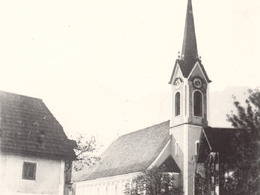Themed trail "Beginnings of the labour movement"




- pets allowed
- All weather
- Suitable for families
- Flatly
Interactive elevation profile
Create PDF
Tour-Details
Paths covering:
Founded on 26 July 1868, the Goisern Workers' Education Association was not only one of the first in the Danube Monarchy, it was also one of the most active and successful of its time. To mark the 150th anniversary of its founding on 27 September 2018, the most important milestones were summarised and documented in the "Beginnings of the labour movement" themed trail. The approx. 30-minute leisurely walk leads through the town centre of Bad Goisern am Hallstättersee past the 12 stations.
The theme trail "Beginnings of the labour movement"
1. Protestant church
The starting point of the theme trail is the Evangelical church, Protestantism and above all secret Protestantism was very pronounced in Bad Goisern and formed the spiritual breeding ground for self-help. The current church dates from 1813-1816, the tower was only added in 1857.
2. Neuwildenstein Castle
The Schloss Neuwildenstein was the seat of power of the Wildenstein sovereign administration from 1715 to 1848. Until 1850, it hosted the care office and the care court as well as the property management (tax office) and thus gave Goisern its headquarters in the Inner Salzkammergut. Today, the castle houses the forestry administration of the ÖBF. The baroque functional building encloses an atmospheric courtyard where concerts are still held today.
3. Holzknechtmuseum
This typical Holzknechtstube was dismantled in the Weißenbachtal valley in 1977 and rebuilt by the local heritage association and converted into a Holzknechtmuseum. The old equipment and tools as well as diagrams give visitors an insight into the arduous life of the woodcutters. Here, they had to work, live and sleep together during the week, away from their families. This resulted in a strong sense of solidarity among the workers.
4. Konrad Deubler Memorial
The monument originally stood in Deublerallee below his estate. The monument was moved to its current location in the Kurpark when the bypass was built. Konrad Deubler (1814-1884), who was nicknamed the farm philosopher due to his diverse interests and intensive studies, was one of Goisern's most colourful personalities. He was a miller in Hallstatt and later an innkeeper in Goisern and was on friendly terms with many intellectual greats and free thinkers of his time. He made a great contribution to the beginnings of the labour movement and to the development of tourism. In 1870-1871, he was one of the first mayors in Goisern.
5. Feuerbachvilla
The property built by Konrad Deubler for his highly esteemed guests was named after the philosopher Ludwig Feuerbach. The villa is now privately owned.
6. Former Wartburg Inn
The house was acquired by Konrad Deubler in 1850 and was a meeting place for free thinkers, doubters and revolutionaries. On the first floor there was an extensive library in which also forbidden writings could be found. Today, it houses a weapons shop.
7. Former Kirchenwirt Inn
The Goisern Workers' Association was founded here on 26 July 1868, initially as a branch of Hallstatt and later, at Deubler's insistence, as an independent association. Today, the building is a condominium complex.
8. Former Konsum building
After the founding of the workers' education association, the Konsumverein was founded in December 1868 to supply the population. It developed into the largest in the Salzkammergut and was the local supplier for the people of Goisern for over 140 years. Everyone in Goisern, not just its own members, could do their shopping here. In addition to the sales shop, the consumer association had its own art mill (acquired in 1874), a bakery, a butchery and a inn (purchased in 1888). The building was erected in 1873 and is now a condominium complex.
9. Former savings and credit association
The former savings and credit association was founded in 1873 and was initially located in the Konsumverein building before moving into its own building. In 1952, it joined the Association of Volksbanks and moved again in 1963 to the bank building on Marktplatz. The old building is now privately owned and there is a pizzeria on the ground floor.
10th primary schools in Bad Goisern
After the workers' education association did not want to place the education of children solely in the hands of the clergy, the Volksschule Bad Goisern. This was the second public school in Upper Austria. A beer tax was levied to finance the construction of the school and the new building was opened just 3 years later in 1898.
11th Fire Damage Protection Association
The last founding initiative of the Workers' Education Association was the Fire Damage Protection Association, which was founded in 1892. There was already a farmers' assecurity association that existed for the neighbouring farmsteads. The densely built-up areas were then also included in the new fire damage insurance association. The original building also housed the Altersversorgungsverein, which was founded in 1876.
12th library
The initial holdings of the library of the Arbeiterbildungsverein came from Konrad Deubler. Financed by the lending fee, dozens of new volumes were added every year, so that today it holds over 8000 volumes. The community library is still run today and is located in Schmiedgasse.
The Workers' Education Association
The workers in the Inner Salzkammergut have always been very self-conscious, as the monarchy was dependent on the income from salt production. They were also mainly Protestants and not used to submitting to the authorities anyway.
During the Counter-Reformation at the end of the 16th century, many Goiserners became secret Protestants. They celebrated their worship services at Schwarzenbachloch and the Kalmooskirche. The period of the Counter-Reformation only ended with the Tolerance Patent in 1781. Just one year later, the Protestant parish comprised 1117 people.
After the introduction of the Basic Law of the State in 1867, the people of Goisern took the opportunity to organise themselves and found a private association.
The movement began with an "educational association", as the activists were primarily concerned with the emancipation of workers through their own efforts. However, self-help organisations such as a consumption association, an age and health insurance association and a savings and credit association (today Volksbank) as well as the fire damage insurance (today Bad Goiserer Versicherung) founded in 1892 also emerged.
The leader of the labour movement was Konrad Deubler (1814-1884), also known as the "farmer philosopher". The Goisern innkeeper and miller opened the "Zur Wartburg" inn in Kirchengasse, where the workers gathered.
Detailed information on the individual stations can be found in the related folder, which is available free of charge at the Tourism Association.
More hiking options
You can find more hikes from easy to difficult on our Hiking page discover.
In an emergency, call the mountain rescue service on 140
Experience a 360° panoramic tour through Bad Goisern on Lake Hallstatt...
Enter the roundabout on the B145, take the Bad Goisern Zentrum exit and turn right at the first bend into the car park behind the Hand.Werk.Haus. From there you can reach the starting point of the educational trail (Protestant church) in about 5 to 10 minutes on foot.
By car
From Salzburg:
Exit Thalgau via federal road B158 towards Bad Ischl, in Bad Ischl take the Salzkammergut road B145 towards Bad Goisern.
From Linz:
Motorway exit Regau on Salzkammergut road B145 towards Gmunden and Bad Ischl to Bad Goisern.
From Vienna/Graz:
Motorway exit Liezen on B320, in Trautenfels turn onto Salzkammergut Straße B145 to Bad Goisern.
From Villach:
Tauern motorway to exit "Eben im Pongau", via B166 Pass Gschütt Bundesstraße through Gosau, turn left at the Gosaumühle junction towards Bad Goisern.
By train
Train Attnang-Puchheim - Stainach-Irdning:
Stops Goisern Jodschwefelbad, Bad Goisern railway station, Steeg / Gosau.
By bus
Bus 541 & 542 (Bad Ischl - Lake Gosau):
Stops Bad Goisern Jodschwefelbad, Bad Goisern Kurhotel, Bad Goisern Mitte/B145, Stambach StrKrzg., St. Agatha Agathawirt, Stambach Angerer, Steeg Reitern, Steeg Au, Steeg Bahnhof, Steeg Traunbrücke, Steeg E-Werk.
Detailed information on the respective Train- and Bus times can be found here!
- Parking space: 30
free of charge
- Free entry
- All weather
- Suitable for groups
- Suitable for schools
- Pets allowed
- Suitable for seniors
- Suitable for single travelers
- Suitable for families
- Suitable for friends
- Suitable for couples
- Suitable for children
- Spring
- Summer
- Autumn
- Early winter
- Deep winter
Please get in touch for more information.
Kirchengasse 4
4822 Bad Goisern am Hallstättersee
Phone +43 5 95095 - 10
E-Mail goisern@dachstein-salzkammergut.at
Web dachstein.salzkammergut.at
You can also visit us on
Visit us on Facebook Visit us on Instagram Visit us on TikTok Visit us on Pinterest Visit our videochannel on YouTube WikipediaInteractive elevation profile
Create PDF
Tour-Details
Paths covering:

